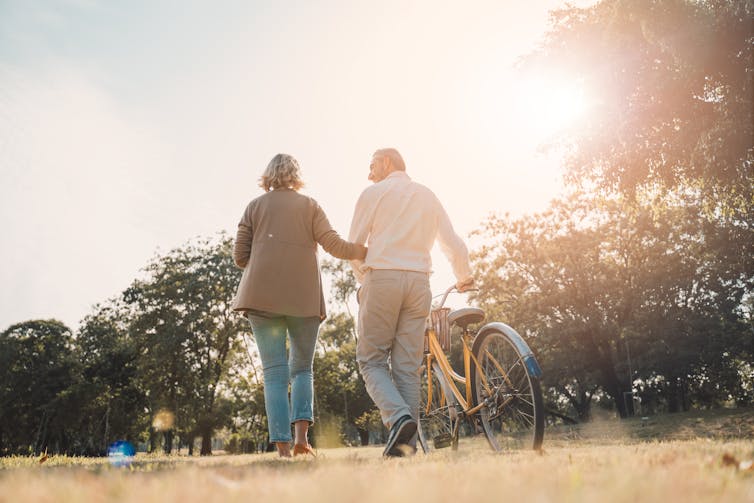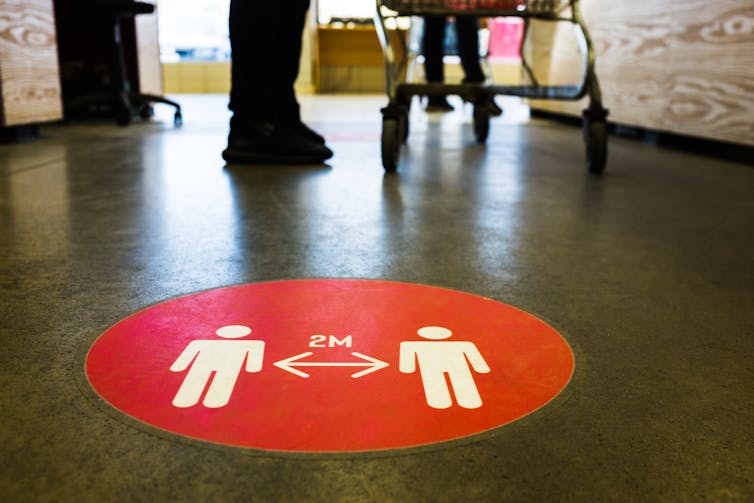
Kieran Sharkey, University of Liverpool
At face value, it seems highly plausible that SARS-CoV-2 – the virus that causes COVID-19 – could behave seasonally, being more prevalent in winter and less so in summer. The four other coronaviruses that commonly circulate in humans behave in this way. We’ve also seen COVID-19 cases, hospitalisations and deaths spike over winter in the UK and other countries, which is suggestive of a seasonal effect.
Some association between viral transmission and the seasons is to be expected. Many human behaviours are seasonal. In summer, we spend more time outdoors, where risk of infection is much lower, and we are likely to lead more active lifestyles, which can raise the body’s ability to resist infection. We’re also likely to benefit from increased exposure to sunlight, which raises vitamin D levels and so can boost our immune systems.
There’s also evidence that the ultraviolet (UV) radiation in sunlight reduces how long the virus can survive on surfaces. It’s also possible that humidity and temperature may influence transmission. When combined together, these factors will likely have an effect on the virus’s spread.
But how significant is this effect? And what are the implications for controlling COVID-19 as we begin to approach the warmer months, as well as for the potential of another winter resurgence? As existing research had produced inconclusive results on whether and how the seasons affect SARS-CoV-2, my colleagues and I set out to see if we could find some more conclusive answers to these questions.
Assessing the impact of climate
Epidemiologists use something called the reproductive number, or R, to describe the growth of an epidemic – the higher the R number, the faster the spread. At the start of an epidemic, its growth won’t be affected by anyone having been exposed to the disease and developing immunity and so it will spread exponentially. At this point the R number that describes this spread is referred to as R₀.
Using data from outbreaks around the world, our new research determined R₀ for COVID-19 in 359 large cities. Each city included in our study had over 500,000 inhabitants and had experienced a significant COVID-19 outbreak in 2020.
We focused on large cities (rather than on countries or on smaller populations) because these allowed us to look at outbreaks that were big enough and sufficiently geographically varied to allow for useful comparisons. By comparing cities’ outbreak data against information on their demographics, climate and infection control measures, we could then determine whether any of these factors explained the rate of spread of the virus.

Fit Ztudio/Shutterstock
We found that increased UV radiation corresponded with a reduction in how rapidly the virus spread. On average, R₀ decreased by 0.05 for every ten kilojoules per square metre (kJ/m²) increase in daily UV radiation (cities in our dataset ranged from receiving 30kJ/m² to around 130kJ/m² of UV each day).
As UV radiation levels are higher in summer, our findings suggest there is indeed some seasonal effect on transmission. However, it’s important to note that this correlation doesn’t necessarily mean that UV radiation is the cause of this decrease in transmission, since UV radiation may correlate with other causal factors.
For example, the higher the UV radiation in a city, the hotter it tends to be. We didn’t find a separate statistically significant link between R₀ and temperature or humidity on a global level, but we can’t rule out such relationships.
Association between viral spread and temperature or humidity may have been masked by many other factors that affect R₀, as well as the strong correlation between UV radiation and temperature. Indeed, there’s some weak evidence of an association between viral spread and temperature in other studies.
So what does this mean?
While the effect of UV radiation that we observed was statistically significant, it was relatively small in comparison to other factors. The demographic features of cities, such as their size and amount of air pollution (a potential measure of industrialisation and population congestion), together with public health measures accounted for more of the observed variation we saw in R₀ values.

Cryptographer/Shutterstock
Government interventions accounted for about four times the explainable variation in R₀ compared to UV. Importantly, this is in our control. In the immediate future, potential further waves of the pandemic will be predominantly determined by controls that governments dictate, rather than the weather. Added to this are the effects of the COVID-19 vaccines that are now being rolled out.
In the longer term, questions still remain about whether COVID-19 will become a seasonal endemic infection similar to influenza and other coronaviruses. Our research has identified evidence for small seasonal drivers that may induce this type of variation when COVID-19 likely stabilises as an endemic infectious disease.
But predicting this behaviour for such a complex system as the world is difficult, and as we move out of the initial epidemic phase, the longer-term behaviour of COVID-19 transmission will probably depend on many other factors. These will likely include the level and duration of immunity acquired by infected individuals, as well as the efficacy and length of protection provided by current and future vaccines, and the evolution of new variants of the virus.![]()
Kieran Sharkey, Reader in Mathematical Sciences, University of Liverpool
This article is republished from The Conversation under a Creative Commons license. Read the original article.
==================================
Postiamo una traduzione automatica in italiano ( google translator ) per facilitare la lettura dell’articolo . Naturalmente fa testo la versione originale in lingua inglese ( editor )
L’estate rallenterà la diffusione di COVID-19 ? Una nuova ricerca fa luce
Dichiarazione di divulgazione
Kieran Sharkey riceve finanziamenti dall’Engineering and Physical Sciences Research Council (EPSRC) del Regno Unito.
A prima vista, sembra altamente plausibile che SARS-CoV-2 – il virus che causa COVID-19 – possa comportarsi stagionalmente, essendo più diffuso in inverno e meno in estate. Gli altri quattro coronavirus che comunemente circolano negli esseri umani si comportano in questo modo . Abbiamo anche visto casi di COVID-19, ricoveri e decessi aumentare durante l’inverno nel Regno Unito e in altri paesi, il che è indicativo di un effetto stagionale.
C’è da aspettarsi qualche associazione tra la trasmissione virale e le stagioni. Molti comportamenti umani sono stagionali. In estate, trascorriamo più tempo all’aperto, dove il rischio di infezione è molto più basso , ed è probabile che conduciamo stili di vita più attivi, che possono aumentare la capacità del corpo di resistere alle infezioni. È anche probabile che trarremo beneficio da una maggiore esposizione alla luce solare, che aumenta i livelli di vitamina D e quindi può rafforzare il nostro sistema immunitario.
Ci sono anche prove che la radiazione ultravioletta (UV) della luce solare riduce il tempo in cui il virus può sopravvivere sulle superfici. È anche possibile che l’umidità e la temperatura possano influenzare la trasmissione. Se combinati insieme, questi fattori avranno probabilmente un effetto sulla diffusione del virus.
Ma quanto è significativo questo effetto? E quali sono le implicazioni per il controllo di COVID-19 quando iniziamo ad avvicinarci ai mesi più caldi, così come per il potenziale di un’altra rinascita invernale? Poiché la ricerca esistente aveva prodotto risultati inconcludenti su se e come le stagioni influenzano la SARS-CoV-2, i miei colleghi e io abbiamo deciso di vedere se potevamo trovare alcune risposte più conclusive a queste domande.
Chiare spiegazioni sulla pandemia da una rete di esperti di ricerca
Valutare l’impatto del clima
Gli epidemiologi usano qualcosa chiamato numero riproduttivo, o R, per descrivere la crescita di un’epidemia: più alto è il numero R, più veloce è la diffusione. All’inizio di un’epidemia, la sua crescita non sarà influenzata da chiunque sia stato esposto alla malattia e sviluppando l’immunità e quindi si diffonderà in modo esponenziale. A questo punto il numero R che descrive questa diffusione viene indicato come R₀.
Utilizzando i dati di epidemie in tutto il mondo, la nostra nuova ricerca ha determinato R₀ per COVID-19 in 359 grandi città. Ogni città inclusa nel nostro studio aveva oltre 500.000 abitanti e aveva sperimentato una significativa epidemia di COVID-19 nel 2020.
Ci siamo concentrati sulle grandi città (piuttosto che sui paesi o su popolazioni più piccole) perché questi ci hanno permesso di guardare focolai che erano abbastanza grandi e sufficientemente variati dal punto di vista geografico per consentire confronti utili. Confrontando i dati sull’epidemia delle città con le informazioni sui loro dati demografici, clima e misure di controllo delle infezioni, potremmo quindi determinare se qualcuno di questi fattori spiegasse il tasso di diffusione del virus.

Abbiamo scoperto che una maggiore radiazione UV corrispondeva a una riduzione della rapidità di diffusione del virus. In media, R₀ è diminuito di 0,05 per ogni dieci kilojoule per metro quadrato (kJ / m²) di aumento della radiazione UV giornaliera (le città nel nostro set di dati variavano da 30kJ / m² a circa 130kJ / m² di UV al giorno).
Poiché i livelli di radiazione UV sono più alti in estate, i nostri risultati suggeriscono che ci sia effettivamente qualche effetto stagionale sulla trasmissione. Tuttavia, è importante notare che questa correlazione non significa necessariamente che la radiazione UV sia la causa di questa diminuzione della trasmissione, poiché la radiazione UV può essere correlata ad altri fattori causali.
Ad esempio, maggiore è la radiazione UV in una città, più calda tende ad essere. Non abbiamo trovato un legame statisticamente significativo separato tra R₀ e temperatura o umidità a livello globale, ma non possiamo escludere tali relazioni.
L’associazione tra la diffusione virale e la temperatura o l’umidità potrebbe essere stata mascherata da molti altri fattori che influenzano R₀, così come dalla forte correlazione tra la radiazione UV e la temperatura. In effetti, ci sono alcune deboli prove di un’associazione tra diffusione virale e temperatura in altri studi.
Che cosa significa questo?
Sebbene l’effetto della radiazione UV che abbiamo osservato fosse statisticamente significativo, era relativamente piccolo rispetto ad altri fattori. Le caratteristiche demografiche delle città, come le loro dimensioni e la quantità di inquinamento atmosferico (una potenziale misura dell’industrializzazione e della congestione della popolazione), insieme alle misure di salute pubblica, hanno rappresentato la maggior parte della variazione osservata che abbiamo visto nei valori R₀.

Gli interventi del governo hanno rappresentato circa quattro volte la variazione spiegabile di R₀ rispetto all’UV. È importante sottolineare che questo è sotto il nostro controllo. Nell’immediato futuro, potenziali ulteriori ondate di pandemia saranno determinate prevalentemente dai controlli dettati dai governi, piuttosto che dalle condizioni meteorologiche. A questo si aggiungono gli effetti dei vaccini COVID-19 che sono ora in fase di lancio.
A lungo termine, rimangono ancora dubbi sul fatto che COVID-19 diventerà un’infezione endemica stagionale simile all’influenza e ad altri coronavirus. La nostra ricerca ha identificato prove di piccoli fattori stagionali che possono indurre questo tipo di variazione quando il COVID-19 si stabilizza probabilmente come malattia infettiva endemica.
Ma prevedere questo comportamento per un sistema così complesso come il mondo è difficile, e mentre ci allontaniamo dalla fase epidemica iniziale, il comportamento a lungo termine della trasmissione di COVID-19 dipenderà probabilmente da molti altri fattori. Questi includeranno probabilmente il livello e la durata dell’immunità acquisita da individui infetti, nonché l’efficacia e la durata della protezione fornita dai vaccini attuali e futuri e l’evoluzione di nuove varianti del virus.
